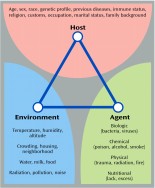In this specific page you will find information on infectious and non-communicable diseases and their relationship with causation theories.
First in business, basic concepts.
- Disease: Disease is a change from the state of good health resulting from a microbial population living in the tissues.
- Infectious diseases: Infection refers to an invasion of body tissues by microorganisms.
- Non-communicable diseases: Are a type of disease that is not transmissible from the infected host to another.
Now that we have those concepts down we will analyze the infectious and non-communicable diseases more deeply as well as study the relationship they have with the causation theories.
Causation Theories
There are many causations theories on why diseases happen. We have studied the 5 more common.
- Germ Theory
- Epidemiological triangle
- Web of causation
- General susceptibility
- Socioenvironmental approach
Germ Theory: It states that disease is caused by transmissible agents only and the medical practice consists of identifying and neutralizing these agents.
Worldwide, one death in three is from an infectious or communicable disease, such as HIV/AIDS. However, almost all these deaths occur in the non-industrialized world. Health inequality effects not just how people live, but often dictates how and at what age they die.The pie graphs show the different causes of death between regions of the world defined by the WHO as high and low mortality regions. These areas correspond closely with the non-industrialized and industrialized parts of the world. As the graph shows, the majority of people in high-mortality countries die of communicable diseases, while in low-mortality countries deaths are due largely to non-communicable diseases.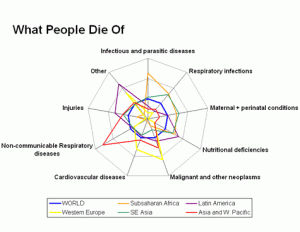
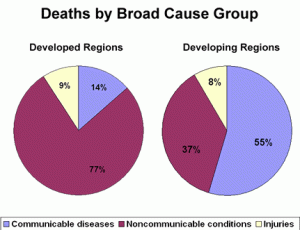
The Non-Communicable Diseases
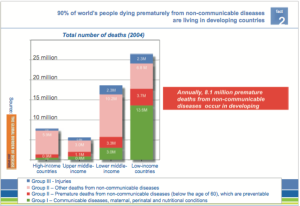
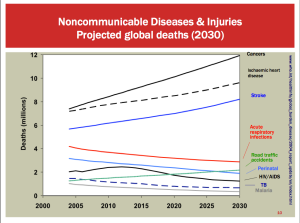
As it can be seen if those graphs (click on them to see better) noncommunicable diseases such as cancer, cardiovascular disease, and diabetes—the most common causes of deaths in wealthier countries—are increasingly common in developing countries. NCDs now account for most deaths and their prevalence is rising. Both the risk factors that contribute to and the positive health behaviors that can prevent NCDs typically start in youth. This video outlines the global rise in NCDs and what measures during youth can prevent future NCDs. Though NCDs are a common cause of death in the welthier countries there is a shocking number that Nearly 80% of NCD deaths – 29 million – occur in low- and middle-income countries.
Infectious diseases
AIDS is Top Cause of Death in Developing Regions
HIV/AIDS has become a sudden and prominent cause of death. In 2001 it was the leading cause of death in non-industrialized regions, claiming 2.7 million lives. In Sub-saharan Africa alone, it claimed 1.9 million lives, and is significantly impacting the Life Expectancy of these countries, as can be seen in the Life Expectancy maps. While HIV/AIDS is an issue in the industrialized world, the number of deaths is significantly less. In 2001, 169,000 people died of HIV/AIDS, or 5% of the world total.
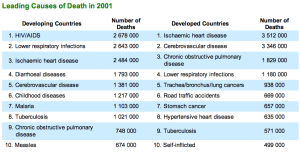 Other communicable diseases, along with nutritional deficiencies, and maternal and perinatal diseases, continue to take a heavy and largely avoidable toll. According to data from the World Health Organization, in 2001 12.8 deaths were due to these causes, with more than 11 million in non-industrialized regions, mainly India and Sub-Saharan African. Together diarrhoeal diseases and lower respiratory infections (including pneumonia) caused 40% of these deaths. Together diarrhoeal diseases and lower respiratory infections (including pneumonia) caused 40% of these deaths. Lower respiratory infections killed 3.8 million people, with 2.6 million deaths in the non-industrialized regions. Diarrhoeal diseases caused 1.8 mn deaths, and nearly all were in the non-industrialized world. Tuberculosis, measles and malaria continue to be major threats. In 1990, they collectively killed 2.8 million people in the non-industrialized world — yet barely registered in the industrialized world. .8 million people in the non-industrialized world — yet barely registered in the industrialized world.
Other communicable diseases, along with nutritional deficiencies, and maternal and perinatal diseases, continue to take a heavy and largely avoidable toll. According to data from the World Health Organization, in 2001 12.8 deaths were due to these causes, with more than 11 million in non-industrialized regions, mainly India and Sub-Saharan African. Together diarrhoeal diseases and lower respiratory infections (including pneumonia) caused 40% of these deaths. Together diarrhoeal diseases and lower respiratory infections (including pneumonia) caused 40% of these deaths. Lower respiratory infections killed 3.8 million people, with 2.6 million deaths in the non-industrialized regions. Diarrhoeal diseases caused 1.8 mn deaths, and nearly all were in the non-industrialized world. Tuberculosis, measles and malaria continue to be major threats. In 1990, they collectively killed 2.8 million people in the non-industrialized world — yet barely registered in the industrialized world. .8 million people in the non-industrialized world — yet barely registered in the industrialized world.
Infectious diseases disproportionately affect children and childhood death rates.A baby girl born in Sub-Saharan Africa faces a 22 per cent risk of death before age 15. In China the risk is less than 5 per cent and in Industrialized countries the risk is just 1.1 per cent. The vast majority of these deaths could have been prevented with existing interventions.
The Relationship
Now that we have studied the type of diseases and the theories for their causation we can see a relationship. So, if we go with the first causation theory, “only agent causes disease” we see it very visible that disease also has to do with the environment. If we look closely in all the graphs of the morbidity and mortality, it is not hard to realize that some diseases happen more or less depending the ages and the countries. Having said this, we see more liable that disease has many causes. All the graphs show how the rate depends if a country is a developed one or a developing one, and also on each disease happens differently depending the age and gender.
What we could pick out from all our investigation is that the environment and the persons life style affects each person’s health. The information recovered in the charts show that the Developed countries, since they are more developed they don’t have such a big rate on infectious diseases, because they have the economical supply; this means that their countries are cleaner and people have the opportunity to live in a house. So there is less possibility of infectious diseases, but when people are more healthy on that side, one the other one NCDs (cancer, diabetes, obesity, etc) are all the diseases that account on the people’s life style; they can eat more than they need to, so they don’t have a healthy diet; they have cars and entertainment that demands no physical activity so they don’t exercise; they can afford cigarettes, so they smoke, a lot. And from all these unhealthy habits worse diseases develop. The causation theory here applies on how diseases depend on something more than just and agent invading your body.
The infectious diseases are more common on developing countries, because they are still growing and not quite stable, so not everybody has the same opportunities that people living in developed nations do. Since they don’t have as much advance, they contagion happens easily. On the other side, for not having all the other these wealthier people do, they exercise more. Still since they are developing sometimes they don’t count with the opportunity of having a healthy diet. We think poverty has a huge wight on disease.
After all, we consider all these information can prove that yes, disease maybe caused by an agent, but there is so much more to how it got there and a lot of background on why people get sick in the first place.
References
“Microbiology: Infection and Disease.” Microbiology: Infection and Disease. N.p., n.d. Web. 02 Feb. 2013. http://www.cliffsnotes.com/study_guide/Infection-and-Disease.topicArticleId-8524,articleId-8463.html
“Non-communicable Disease.” – Definition from Biology-Online.org. N.p., n.d. Web. 02 Feb. 2013. http://www.biology-online.org/dictionary/Non-communicable_disease
http://www.global-doctors.org/wp-content/uploads/2012/04/Prof.-de-Courtens-presentation.pdf
“Infectious Diseases.” Emerging Infection and Bioterrorism. N.p., n.d. Web. 02 Feb. 2013. http://www.bcm.edu/molvir/id

